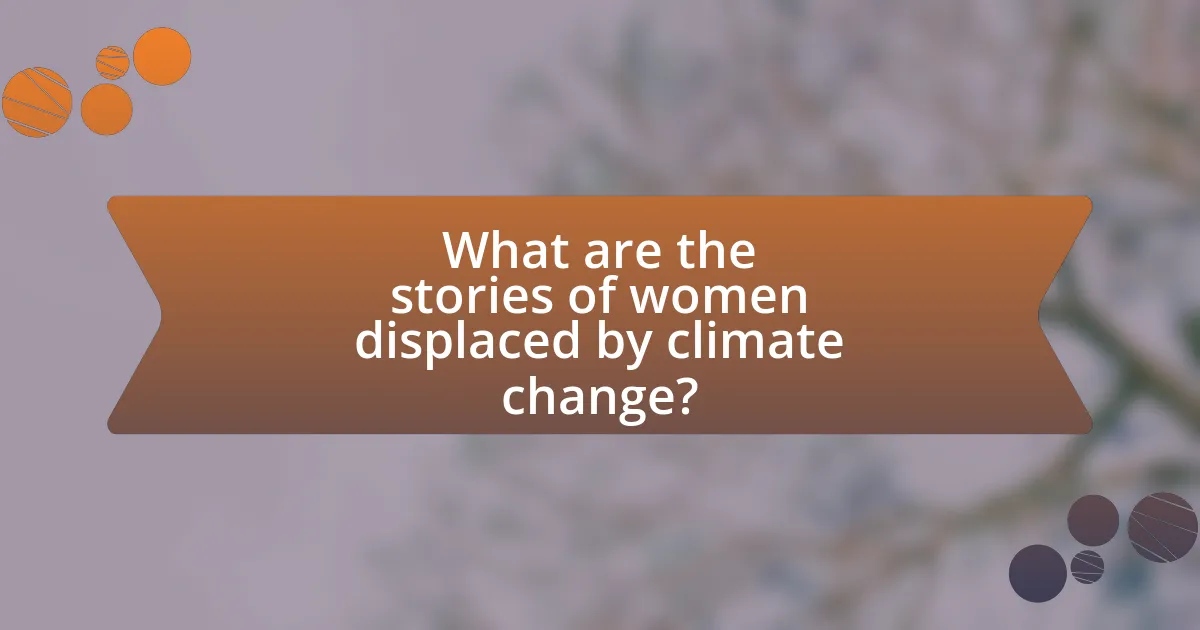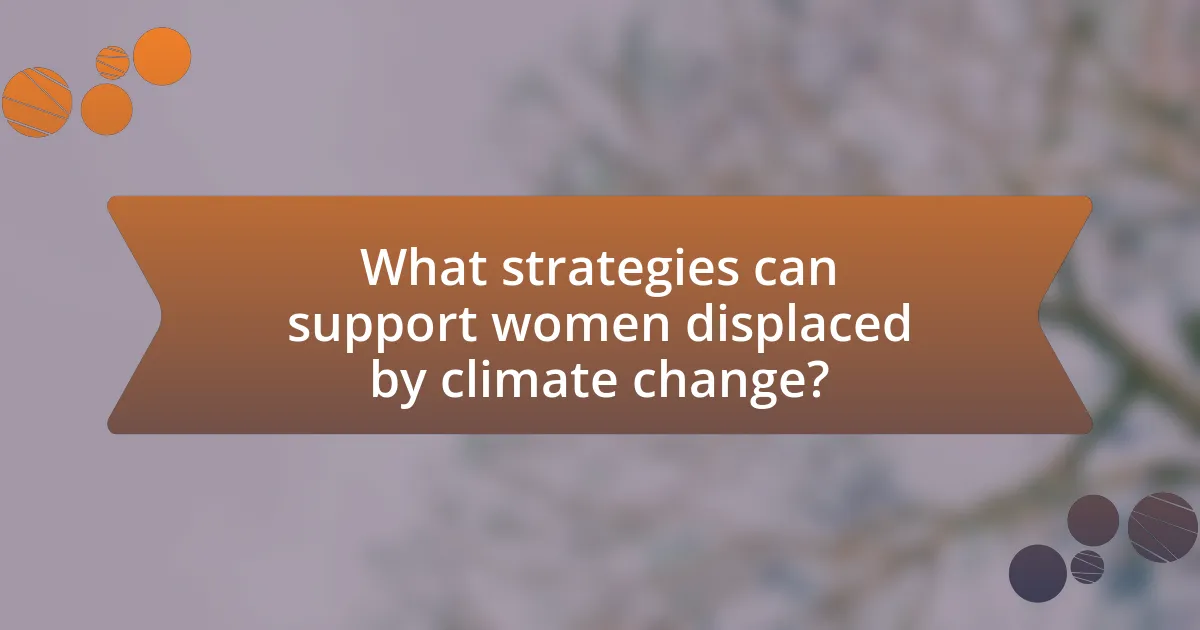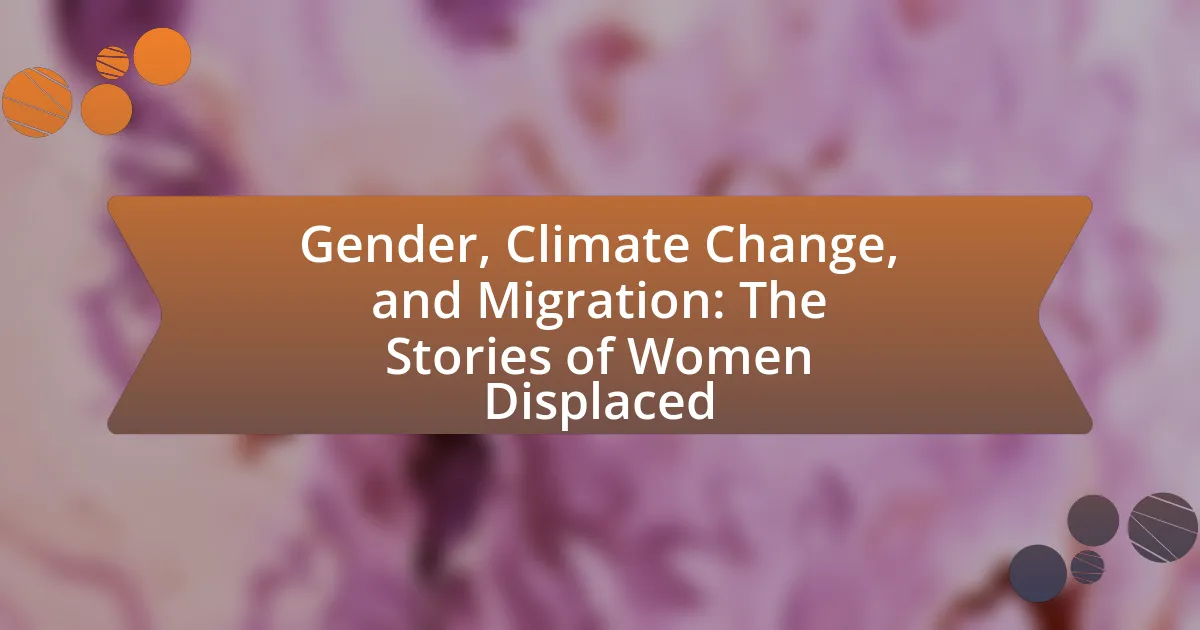The article examines the critical relationship between gender, climate change, and migration, focusing on the unique vulnerabilities faced by women during climate-induced displacement. It highlights how climate change exacerbates resource scarcity, disproportionately affecting women who are integral to household management and agriculture. The discussion includes the socio-economic factors influencing women’s migration patterns, the specific challenges they encounter in host communities, and the importance of integrating gender perspectives into climate policies and migration strategies. Additionally, it emphasizes the resilience of displaced women and outlines strategies to support their recovery and empowerment in the face of climate challenges.

What is the relationship between gender, climate change, and migration?
The relationship between gender, climate change, and migration is significant, as women often face unique vulnerabilities during climate-induced displacement. Climate change exacerbates environmental degradation, leading to resource scarcity, which disproportionately affects women due to their roles in household management and agriculture. For instance, a study by the United Nations Framework Convention on Climate Change (UNFCCC) indicates that women make up 43% of the agricultural labor force in developing countries, making them particularly susceptible to the impacts of climate change on food security. Consequently, as climate conditions worsen, women are more likely to migrate in search of better living conditions and resources, highlighting the intersection of gender dynamics and environmental challenges in migration patterns.
How does climate change specifically impact women and their migration patterns?
Climate change significantly impacts women and their migration patterns by exacerbating vulnerabilities related to environmental degradation, economic instability, and social inequalities. Women, particularly in developing countries, often bear the brunt of climate-related disasters, such as floods and droughts, which can lead to loss of livelihoods and increased food insecurity. For instance, the United Nations reports that women are more likely to be displaced during climate events due to their roles in household management and agriculture, which are directly affected by changing weather patterns. Additionally, as resources become scarcer, women may migrate to urban areas in search of better opportunities, often facing increased risks of exploitation and violence during their journeys. This migration is not just a response to immediate environmental changes but also reflects long-term socio-economic pressures intensified by climate change.
What are the unique vulnerabilities faced by women in climate-affected regions?
Women in climate-affected regions face unique vulnerabilities such as increased exposure to gender-based violence, limited access to resources, and heightened economic insecurity. These vulnerabilities are exacerbated by social norms and structures that often marginalize women, making them more susceptible to the impacts of climate change. For instance, during natural disasters, women are frequently at a higher risk of violence and exploitation, as evidenced by reports from organizations like the United Nations, which highlight that women and girls are disproportionately affected in crisis situations. Additionally, women’s roles in agriculture and resource management mean that climate change can severely disrupt their livelihoods, leading to economic instability. According to the World Bank, women represent a significant portion of the agricultural workforce in developing countries, and climate-related disruptions can threaten their food security and economic independence.
How do socio-economic factors influence women’s migration due to climate change?
Socio-economic factors significantly influence women’s migration due to climate change by determining their access to resources, decision-making power, and vulnerability to environmental changes. Women in lower socio-economic strata often lack financial resources, education, and social networks, which limits their ability to migrate in response to climate-induced disasters. For instance, a study by the International Organization for Migration found that women from impoverished communities are more likely to remain in hazardous areas due to economic constraints, while those with better socio-economic status can relocate to safer environments. Additionally, socio-economic factors shape women’s roles in households, where traditional expectations may restrict their mobility, further complicating their ability to migrate when faced with climate threats.
Why is it important to consider gender in discussions about climate change and migration?
Considering gender in discussions about climate change and migration is crucial because women and men experience the impacts of climate change differently, influencing their migration patterns and vulnerabilities. Research indicates that women are often more affected by climate-related disasters due to existing social inequalities, which can limit their access to resources, decision-making, and mobility. For instance, the United Nations reports that women represent 70% of the world’s poor, making them more susceptible to the adverse effects of climate change, such as food insecurity and displacement. Additionally, gender-specific roles and responsibilities can affect how communities adapt to climate change, with women frequently being primary caregivers and resource managers. Therefore, integrating gender perspectives ensures that policies address the unique challenges faced by women, ultimately leading to more effective climate adaptation and migration strategies.
What role does gender play in shaping migration policies related to climate change?
Gender significantly influences the formulation of migration policies related to climate change by highlighting the distinct vulnerabilities and needs of women and men in displacement scenarios. Women often face greater risks due to socio-economic inequalities, which necessitates the integration of gender-sensitive approaches in policy-making. For instance, the United Nations Framework Convention on Climate Change emphasizes the importance of gender in addressing climate impacts, recognizing that women are disproportionately affected by environmental changes and often serve as primary caregivers and resource managers. This recognition leads to policies that aim to empower women, ensuring their participation in decision-making processes and access to resources, thereby enhancing resilience against climate-induced migration.
How can understanding gender dynamics improve climate resilience strategies?
Understanding gender dynamics can significantly enhance climate resilience strategies by ensuring that the unique needs and contributions of different genders are recognized and integrated into planning and implementation. Research indicates that women often play crucial roles in resource management and community resilience, yet they frequently face barriers that limit their participation in decision-making processes. For instance, a study by the United Nations Development Programme highlights that women are disproportionately affected by climate change impacts, which can exacerbate existing inequalities. By incorporating gender perspectives, strategies can be tailored to leverage women’s knowledge and skills, ultimately leading to more effective and sustainable climate adaptation measures.

What are the stories of women displaced by climate change?
Women displaced by climate change often face unique challenges and experiences that highlight their resilience and vulnerability. For instance, in Bangladesh, women from coastal communities are increasingly forced to migrate due to rising sea levels and extreme weather events. These women often become the primary caregivers for their families, taking on additional responsibilities as they seek new livelihoods in urban areas.
In the Sahel region of Africa, women are disproportionately affected by desertification, which leads to food insecurity and displacement. They frequently engage in climate adaptation strategies, such as diversifying crops or seeking alternative income sources, to support their families amidst changing environmental conditions.
Research by the United Nations highlights that women represent 80% of those displaced by climate-related disasters, emphasizing their critical role in community resilience and adaptation efforts. These stories illustrate the intersection of gender, climate change, and migration, showcasing both the struggles and strengths of women facing displacement.
What common experiences do these women share in their displacement journeys?
Women displaced by climate change commonly experience loss of home, economic instability, and social marginalization. These women often face the destruction of their communities due to environmental factors such as floods, droughts, and rising sea levels, which forces them to leave their homes. Economic instability arises as they lose their livelihoods, particularly in agriculture and fishing, which are heavily impacted by climate change. Additionally, social marginalization occurs as displaced women frequently encounter discrimination and lack access to resources and support systems in host communities, exacerbating their vulnerability. Studies indicate that women are disproportionately affected by climate-related displacement, highlighting the need for targeted interventions to address their unique challenges.
How do cultural and social contexts affect their migration experiences?
Cultural and social contexts significantly shape migration experiences by influencing the opportunities, challenges, and support systems available to migrants. For instance, women facing displacement due to climate change often encounter gender-specific barriers, such as limited access to resources and decision-making power, which can hinder their ability to migrate safely and effectively. Research indicates that in many cultures, traditional gender roles restrict women’s mobility and autonomy, making it difficult for them to seek refuge or employment in new locations. Additionally, social networks within migrant communities can either facilitate integration and support or exacerbate isolation, depending on the prevailing cultural attitudes towards gender and migration. Studies have shown that women who migrate within supportive social contexts tend to have better outcomes in terms of employment and community acceptance, highlighting the critical role of cultural and social factors in shaping their migration experiences.
What challenges do they face in host communities after displacement?
Displaced individuals, particularly women, face significant challenges in host communities after displacement, including limited access to resources, social stigma, and heightened vulnerability to gender-based violence. These challenges arise as host communities often lack the infrastructure and support systems necessary to accommodate an influx of displaced persons, leading to competition for scarce resources such as housing, employment, and healthcare. Additionally, social stigma can marginalize displaced individuals, making it difficult for them to integrate and access essential services. Reports indicate that women in these situations are particularly at risk, with studies showing that displacement can increase their exposure to violence and exploitation, as evidenced by a 2021 UN Women report highlighting that displaced women are more likely to experience domestic violence and sexual harassment in host communities.
How do these stories highlight the intersection of gender and climate change?
These stories highlight the intersection of gender and climate change by illustrating how women disproportionately experience the impacts of environmental degradation and displacement. Research indicates that women are often the primary caregivers and resource managers in their communities, making them more vulnerable to climate-related challenges such as food insecurity and water scarcity. For instance, the United Nations reports that women represent 70% of the world’s poor, and climate change exacerbates their economic and social vulnerabilities. Additionally, these narratives often showcase women’s resilience and agency in adapting to climate change, emphasizing their critical role in community recovery and sustainability efforts.
What lessons can be learned from the resilience of displaced women?
The resilience of displaced women teaches the importance of adaptability and resourcefulness in the face of adversity. These women often develop innovative coping strategies to navigate their challenging circumstances, demonstrating that resilience can lead to community-building and empowerment. For instance, displaced women frequently engage in collective action, forming support networks that enhance their social capital and provide mutual aid. Research indicates that women who participate in community organizations are more likely to secure resources and improve their living conditions, as seen in studies conducted by the United Nations High Commissioner for Refugees, which highlight the critical role of women in fostering resilience within displaced communities.
How do these narratives inform policy and advocacy efforts?
Narratives about women displaced by climate change inform policy and advocacy efforts by highlighting the unique challenges and vulnerabilities these women face. These stories provide critical insights into the intersection of gender, environmental degradation, and migration, which can shape targeted interventions. For instance, research indicates that women are often responsible for securing water and food, making them disproportionately affected by climate-related disruptions. By incorporating these narratives into policy discussions, advocates can push for gender-sensitive approaches that address the specific needs of displaced women, ultimately leading to more effective and equitable climate adaptation strategies.

What strategies can support women displaced by climate change?
Strategies that can support women displaced by climate change include providing access to education, financial resources, and legal protection. Access to education equips women with skills necessary for employment and self-sufficiency, which is crucial in rebuilding their lives after displacement. Financial resources, such as microloans and grants, enable women to start businesses or support their families, fostering economic independence. Legal protection ensures that women have rights to land and resources, which is vital for their security and stability in new environments. According to the United Nations, empowering women through these strategies can significantly enhance community resilience and recovery in the face of climate-induced challenges.
How can communities better support displaced women during and after migration?
Communities can better support displaced women during and after migration by implementing targeted programs that address their specific needs, such as access to healthcare, legal assistance, and economic opportunities. For instance, providing healthcare services that cater to women’s reproductive health can significantly improve their well-being, as studies show that displaced women often face increased health risks. Additionally, offering legal support helps women navigate complex immigration processes, ensuring their rights are protected. Economic empowerment initiatives, such as job training and microfinance programs, can facilitate financial independence, which is crucial for their stability and integration into new communities. These measures are essential, as research indicates that displaced women are disproportionately affected by economic and social vulnerabilities during migration.
What role do local organizations play in aiding these women?
Local organizations play a crucial role in aiding women displaced by climate change by providing essential support services such as shelter, legal assistance, and access to healthcare. These organizations often serve as the first point of contact for displaced women, helping them navigate the challenges of relocation and integration into new communities. For instance, studies have shown that local NGOs facilitate skills training programs that empower women economically, enabling them to rebuild their lives after displacement. Additionally, local organizations advocate for policy changes that address the specific needs of displaced women, ensuring their voices are heard in decision-making processes.
How can international frameworks be improved to address their needs?
International frameworks can be improved to address the needs of women displaced by climate change by incorporating gender-sensitive policies and ensuring inclusive participation in decision-making processes. Research indicates that women are disproportionately affected by climate-related displacement due to existing gender inequalities, which necessitates tailored approaches that consider their specific vulnerabilities and strengths. For instance, the United Nations Framework Convention on Climate Change (UNFCCC) has recognized the importance of gender-responsive climate action, yet implementation remains inconsistent across member states. By mandating gender analysis in climate adaptation and migration strategies, frameworks can better support women’s rights and enhance their resilience in the face of climate change.
What best practices can be implemented to empower displaced women?
To empower displaced women, best practices include providing access to education, vocational training, and healthcare services. Education equips women with knowledge and skills necessary for economic independence, while vocational training enhances their employability in various sectors. For instance, programs that focus on digital literacy have shown to significantly improve job prospects for women in refugee camps. Additionally, ensuring access to healthcare, including mental health services, addresses the unique challenges faced by displaced women, promoting their overall well-being. According to the UNHCR, empowering women in displacement settings leads to stronger communities and improved resilience against future crises.
How can education and skill development programs be tailored for these women?
Education and skill development programs for women displaced by climate change can be tailored by focusing on their specific needs and circumstances. These programs should incorporate flexible learning options, such as online courses and community-based workshops, to accommodate varying levels of mobility and access to resources. Additionally, they should emphasize skills relevant to sustainable livelihoods, such as agriculture, renewable energy, and entrepreneurship, which are crucial for economic resilience in the face of climate challenges.
Evidence shows that targeted training can significantly improve women’s economic participation; for instance, a study by the International Labour Organization found that women who received vocational training in green jobs increased their income by 30%. By aligning educational content with local market demands and integrating support services like childcare, these programs can enhance accessibility and effectiveness for displaced women.
What resources are available to assist women in rebuilding their lives post-displacement?
Women rebuilding their lives post-displacement can access various resources, including financial assistance programs, legal aid services, mental health support, and vocational training initiatives. Organizations such as the United Nations High Commissioner for Refugees (UNHCR) provide tailored support for displaced women, including access to shelters and community centers that offer counseling and job placement services. Additionally, local NGOs often facilitate workshops that focus on skills development, empowering women to regain economic independence. Research indicates that targeted interventions, such as those provided by the International Rescue Committee, significantly improve the livelihoods of displaced women, highlighting the effectiveness of these resources in fostering resilience and recovery.
What are the key takeaways for addressing gender, climate change, and migration?
Key takeaways for addressing gender, climate change, and migration include recognizing the disproportionate impact of climate change on women, integrating gender perspectives into climate policies, and ensuring women’s participation in decision-making processes related to migration. Research indicates that women are often more vulnerable to climate-related disasters due to existing social inequalities, which can exacerbate their displacement. For instance, the United Nations reports that women make up 80% of those displaced by climate-related events, highlighting the need for targeted interventions. Additionally, incorporating gender-sensitive approaches in climate adaptation strategies can enhance resilience and empower women, ultimately leading to more effective migration management.
